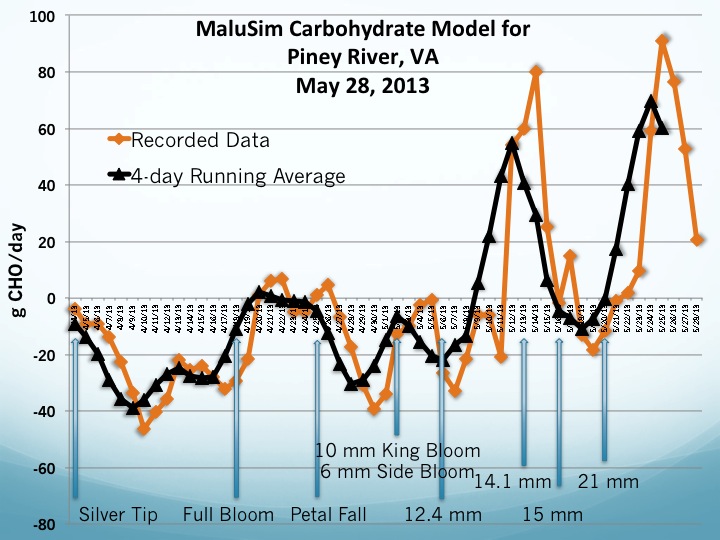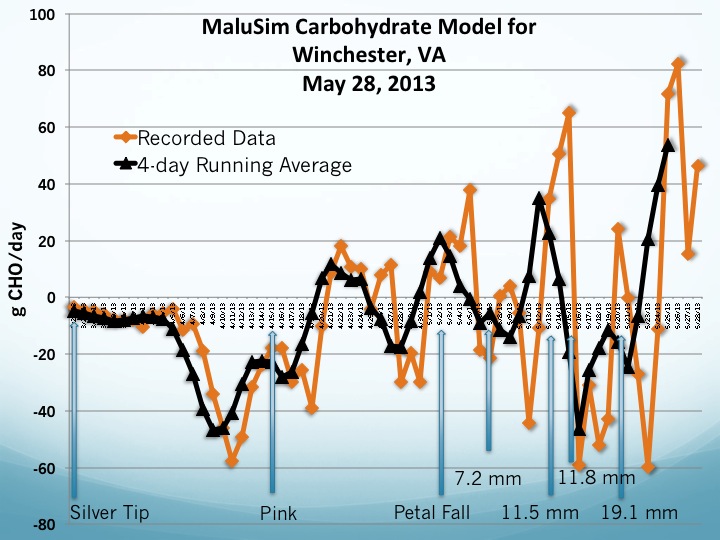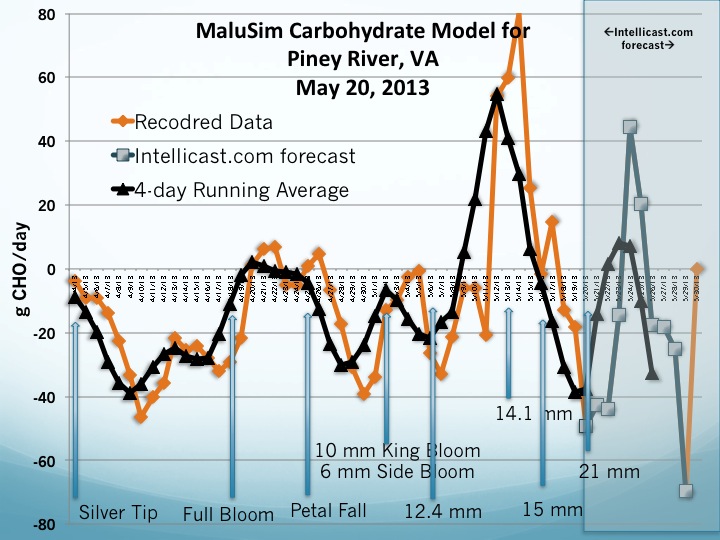By this time, apples in most of Virginia are 13-20 mm in fruit size. Once apples reach this size, the trees tend to be less responsive to the typical 10 mm (carbaryl plus NAA or 6-BA) applications. However, if additional thinning is needed, growers can still use ethephon (sold under the trade names Ethrel and Ethephon 2). Ethephon is most effective when fruit size is 14 to 28 mm in diameter. In most years, it is difficult to chemically thin apples larger than 24 mm.
Ethephon has variable responses due to air temperature and humidity, as well as spray water volumes. Overthinning is more likely with this material than with other thinners. For this reason, ethephon has been primarily used when earlier thinning applications were not successful, on very difficult to thin cultivars, and/or when return bloom has been a severe problem. Thinning results with ethephon varies amongst cultivars. Ethephon is not very effective on Gala, but it is very effective on Golden Delicious and Rome. Where water is alkaline, buffering the spray solution to a pH of 3 to 5 will increase chemical stability and effectiveness. Do not use before a light rain or dew or when post-application temperatures are predicted to be greater than 90˚F because excessive thinning may occur.
Ethephon is usually combined with carbaryl or oxamyl (Vydate L). For greater thinning activity, ethephon can also be tank mixed with NAA and/or spray oil.
I have several research trials underway to look at alternative and hopefully more consistent late thinning materials. However, at this time, ethephon is still the standard material when fruit size is greater than 14 mm.
Once fruit is larger than 28 mm, hand thinning will need to be used to remove additional fruit. Hand thinning will have a positive impact on final fruit size and return bloom for up to about 45 days after full bloom. In 2013, this is around the first week of June for central Virginia and the second week of June for the Winchester area.
PROMOTING RETURN BLOOM IN APPLE
Ethephon (sold under the trade names Ethrel and Ethephon 2) can promote flower bud formation when applied from petal fall to about 6 to 8 weeks after full bloom. The greatest effect is from applications made 0 to 4 weeks after bloom. However, since ethephon can cause substantial fruit thinning, multiple weekly applications at rates 1/2 that of the thinning rate are recommended starting when fruitlets are greater than 30 mm. When possible, it is best to wait until after “June” drop has occurred. At a minimum, wait 7-10 days after the last thinning application before starting ethephon return bloom sprays. Additionally, do not apply ethephon to trees that are stressed or trees that are low in vigor.
A single ethephon application can be used at a high rate (up to 900 ppm). However, more consistent results are often obtained from multiple (3-4) applications made at 10-14 day intervals using lower rates (150-300 ppm). One common, and often effective strategy, is to make two applications in June and two applications in July.
Another strategy is to make 2-4 applications of ethephon at 150 ppm tank mixed with NAA at 5-10 ppm (or 2.5-5 ppm when tank mixed with spray oil). This approach has been beneficial for strongly biennial cultivars.
Sensitivity to ethephon is very different amongst cultivars, thus it is important to choose a rate specific to each variety. Do not exceed 8 pints per acre per year. If trees are over-cropped ethephon may not effectively give adequate return bloom the following season. Higher soluble solids and lower starch levels at harvest may be expected with some cultivars, particularly with high rates and/or late season applications. No loss of firmness has been detected with ‘Red Delicious’ at the optimum harvest date.
Ethephon sprays can reduce tree growth (dependent on timing and amounts used) and thus may not be desirable for young non-bearing trees if maximum tree growth is desirable.
HAND THINNING PEACHES
Hand thinning peaches to 6-8 inches apart on the branch will result in increased final fruit size and help prevent limb breakage. This activity will be most effective when completed over the next couple-few weeks. Hand thinning peaches later in the season will not have as much of an impact on final fruit size.
 Due the rapidly changing weather forecasts, I ran the MaluSim model again on Thursday. For Central Virginia, the model is showing values in the -20 to 20 range for the next seven days. This means
Due the rapidly changing weather forecasts, I ran the MaluSim model again on Thursday. For Central Virginia, the model is showing values in the -20 to 20 range for the next seven days. This means  that growers should expect an “average” response from their chemical thinners. Growers in the Central Virginia region should target the next couple-few days to make their thinning sprays as fruitlets are at the ideal size for applications of NAA and 6-BA. Fruitlets grow at ~0.5 mm/day in cool temperatures, and as you can see from the table below, up to 1 mm/day with warmer temperatures.
that growers should expect an “average” response from their chemical thinners. Growers in the Central Virginia region should target the next couple-few days to make their thinning sprays as fruitlets are at the ideal size for applications of NAA and 6-BA. Fruitlets grow at ~0.5 mm/day in cool temperatures, and as you can see from the table below, up to 1 mm/day with warmer temperatures.











